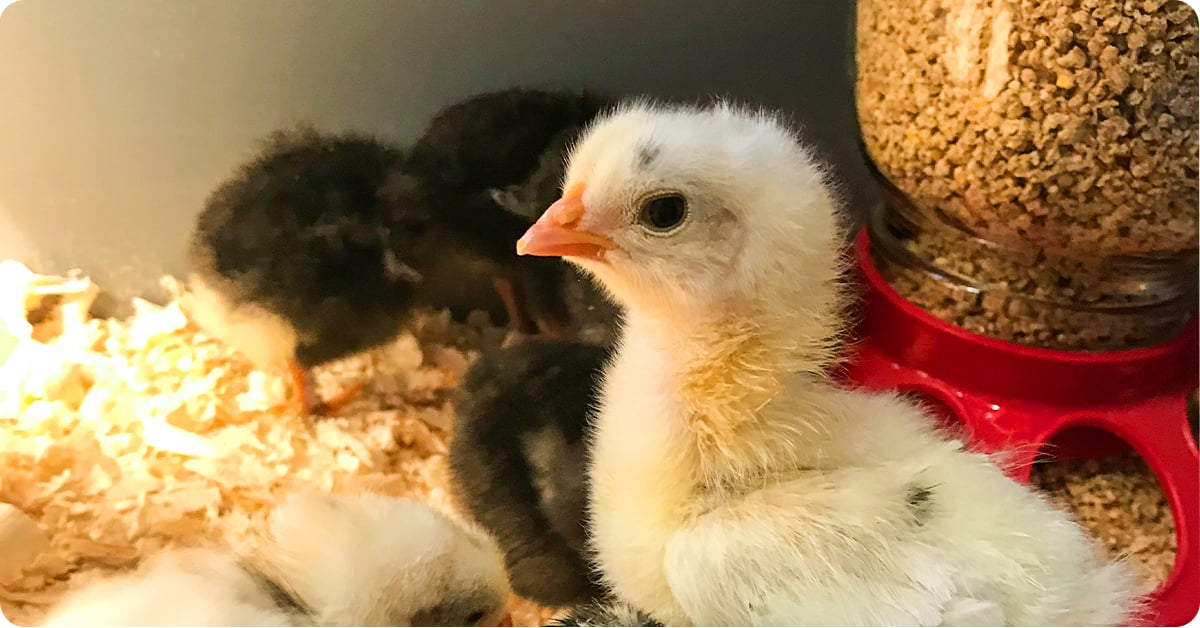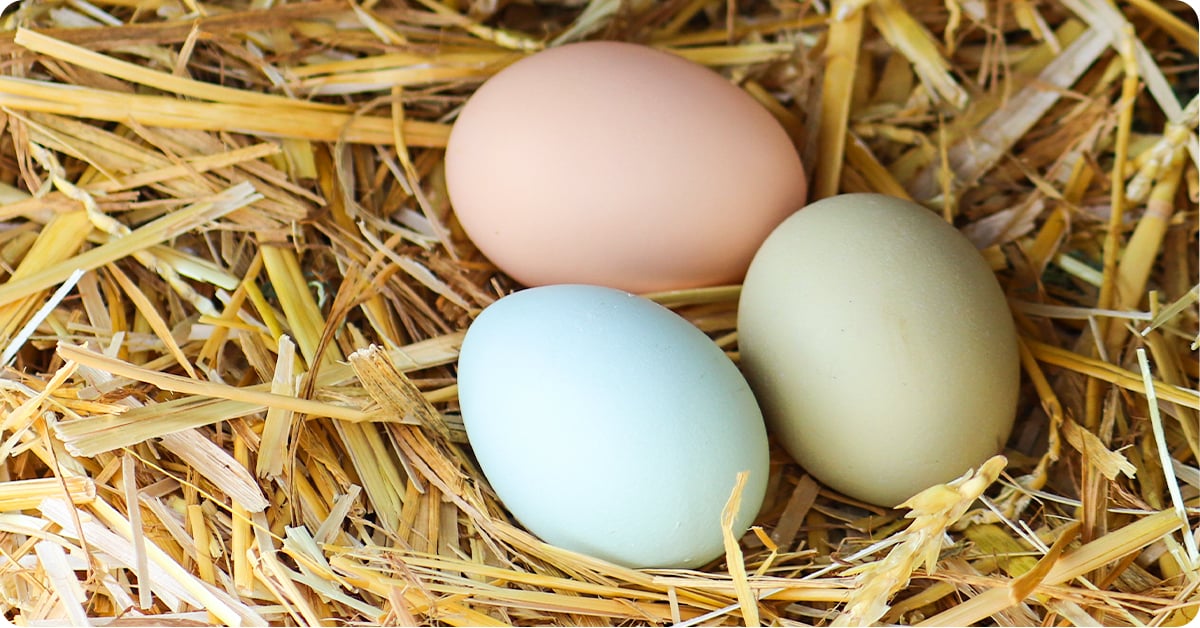
Fluffy chicks are one of the cutest, most-difficult-to-resist animals on Earth each spring. Your backyard could be the perfect paradise for those wee things to grow up and lay eggs for you and your family to enjoy.
But first, deciding to raise chicks takes more than just buying a few and bringing them home. You’ll need a safe, comfortable coop in place for the new chicks to call home. Plus, it should have a reliable heat source, food and water stations, and plenty of premium chicken (poultry) feed. Before getting started, make sure you have all the necessities for raising backyard chickens.
From there, your new chickens will need to be fed within hours of arrival, and every day going forward. Like all growing things, the right nutrients will help them through every stage of life. Keep in mind, chicks grow fast! With a healthy diet, your chickens will be laying eggs before you know it. As your chicks mature, the types of feed they’ll need will change a couple of times, in just a matter of weeks. Let’s take a look at which feeds are best for your chickens, depending on their age.
The Importance of Age-Appropriate Poultry Feed
Starter Feed For Baby Chicks: 0-8 Weeks Old
From birth through about eight weeks, chickens rapidly change as they go from chicks to pullets. Your baby chicks need starter feed to establish and support their bone health and immunity. A healthful starter feed should be filled with complete proteins, amino acids, vitamins, and minerals. Your chicks should eat starter feed for the first eight weeks of their life, until they are introduced to grower feed.

Grower Feed For Pullets: 8-16 Weeks Old
At about eight weeks, chicks are now considered pullets. It’s a good idea to transition them to a grower feed focused on healthy development. At this stage, these feeds should have a slightly lower protein content and calcium level (less than 1.25%), but still include omega-3s and other essential nutrients to support digestion and health.
Layer Feed For Hens: 16+ Weeks
Once your pullets have started laying eggs, it’s time to transition these now hens to a higher-calcium and protein-rich layer feed intended to help them lay strong, healthy eggs. All hens lay eggs on their own schedule. Some can lay as early as 16 weeks; some need as long as 32. You can switch to layer feed at 16 weeks, or wait until you find your first egg. If you’re also raising the flock for their meat, you’ll want to look for a feed with a higher protein content to help them develop strong muscles and keep up their energy.
Poultry Scratch & Other Treats
Chick grit, scratches, and similar supplements are designed to aid chicks, pullets, and hens in food digestion. They should be fed like treats and kept to small amounts with the goal of helping your flock engage their natural instincts for scratching and pecking.

IFA Premium Blend Poultry Scratch is a three-way blend of high-quality grains. This healthful blend of cracked corn, whole wheat, and barley encourages natural scratching and pecking while aiding in digestion. A word of caution: Treats are only a small part of a healthy diet. Scratch and other treats should never make up more than 10% of your flocks’ diet.
What nutrients do your chickens need?
A complete diet ensures your chickens have sufficient energy for laying eggs, staying warm in cold climates, or cooling off in the heat of summer. A good quality feed for chickens has a protein content between 16-20% and is enhanced with omega-3s. Additional nutrients should include prebiotics, probiotics, calcium, and magnesium.

Protein helps chickens maintain their energy levels as they continue to grow and lay. Omega-3s are vital for more nutritious eggs. Prebiotics and probiotics boost immune and digestive health, while calcium–which may deplete with daily egg laying–and magnesium are needed for strong shells and bones.
Keep in mind, chickens eat to fill their nutritional requirements. Supplying your flock a nutrient dense feed will result in less waste, and not all feeds provide everything your chickens need.
IFA’s 3-Step Guide to Feeding Chickens
At IFA, we proudly offer a variety of feed for each stage of your chicken’s development. Our 3-step Guide to feeding chickens is specifically blended by our nutritionists to meet all of your chicken’s nutrient and energy requirements at the proper time. By doing so, it ensures your chickens grow healthy and productive, while laying the most nutritious eggs.
Step 1: Chick Starter Crumble
Our chick starter is formulated to give your chicks their best start at life with 20% protein, omega-3s like DHA for healthy brain development, and prebiotics and probiotics for improved gut health and immune development. Our All Natural+ Chick Starter Crumble is hormone and antibiotic free. Feed from birth to 8 weeks of age.
Step 2: Pullet Developer Crumble
Optimized for healthy growing rates in chickens, our All Natural+ Pullet Developer Crumble has 16% protein. This feed is packed with vitamins and minerals that maintain healthful immunity and bone strength. Use this feed to help your adolescent chickens develop into healthy, laying adults. Feed from 8 weeks until your chickens begin laying.
Step 3: Poultry Layer Pellets, Crumble & Mash
When it comes to our All Natural+ Layer Crumble, you’ll get an excellent blend of 18% protein along with added omega-3s, calcium, and magnesium for mature laying hens. This mix provides balanced nutrition that encourages healthy eggs, digestive systems, and immunity.
For a higher protein content to help meet energy requirements, look for IFA's Premium High Protein Layer Pellet. Expertly formulated by animal nutritionists, this chicken feed provides 20% protein to laying hens along with the complete overall nutrition they need to build strong natural defenses and maximize growth and performance.
The third of our layer feed options is IFA's Premium Classic Layer Mash. Our 16% layer mash provides hens an appealing texture variety with the complete nutrition they need to thrive and consistently produce nutritious eggs. Feed when your chickens begin laying (about 18 weeks).
Additional note: If you keep your flock past their egg laying years, we recommend reverting back to feeding a pullet developer. They will not need the extra calcium that’s present in the layer feed formulas.
Your chickens will begin to molt–lose and replace their feathers–around 18 months and egg production will drop off. During this period, feed your flock with a high protein feed (18-20%). Feathers are made up of protein and a higher protein feed helps ensure they regrow healthy and more quickly. After the molting process is complete, your chickens will begin to lay normally again.

Knowing what to feed your chickens is the first step towards having happy, healthy, and productive flocks throughout their natural egg-laying life. Confidently start your backyard flock of fluffballs this spring with the knowledge that you’re providing the best possible feed for them at every stage of development.
If you have additional questions or need support raising your flock, contact your local IFA. We’ll be happy to help.
Information for this article was provided by Heidi Wayment, M.S., Nutritionist, Draper IFA Feed; Sandie Shupe, Poultry, Rabbit & Animal Health Manager, Ogden IFA Country Store; Maureen Goodrich, Poultry, Rabbit, Pet & Tack Manager, Logan IFA Country Store; and Jill Singleton, Bagged Feed Category Manager, IFA.










